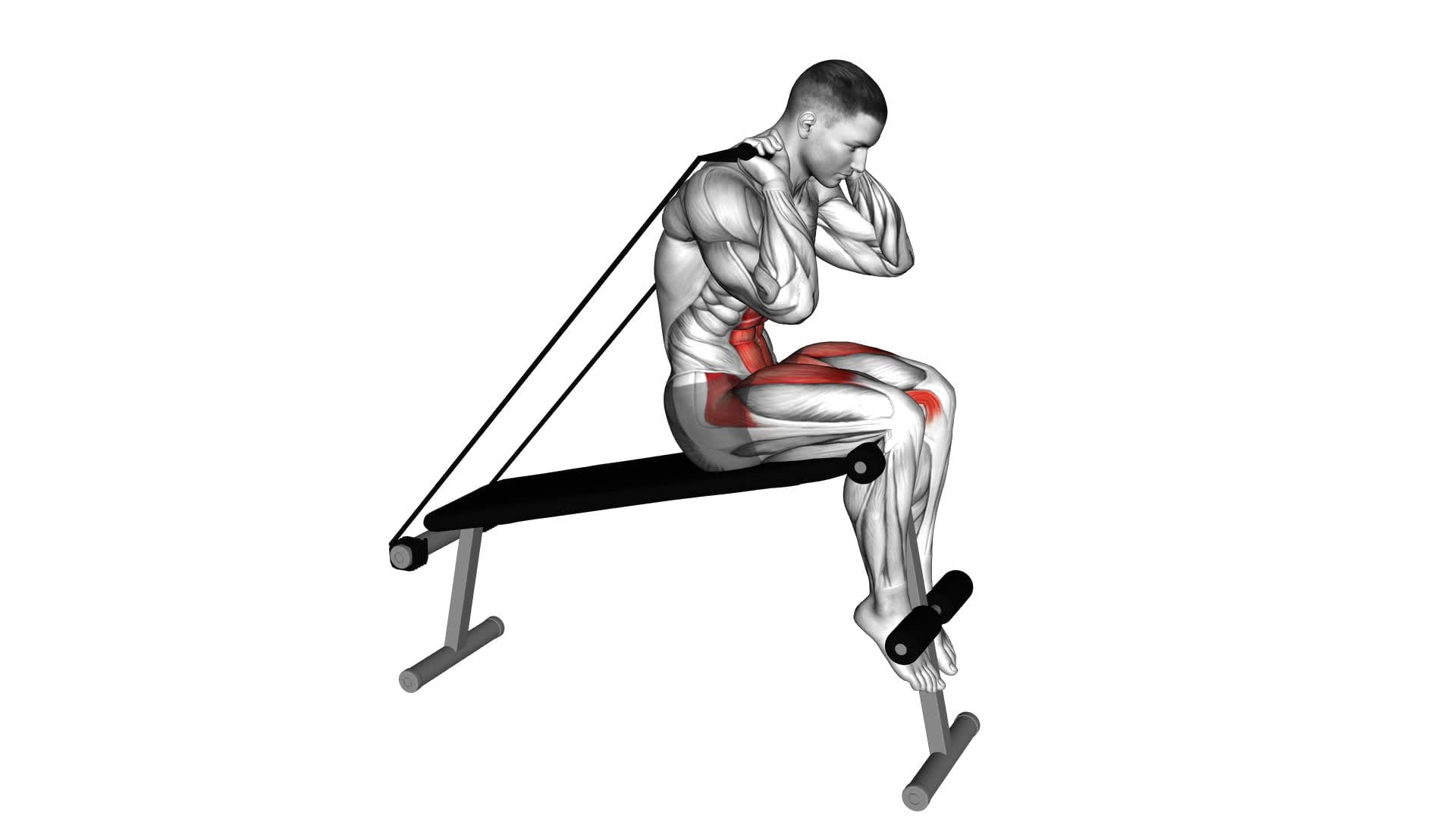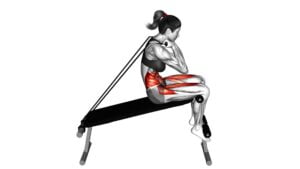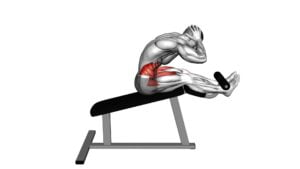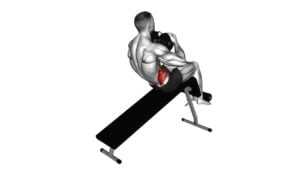Band Decline Sit up – Video Exercise Guide & Tips

Are you looking for an effective way to strengthen your core? Look no further than the band decline sit up!
Watch This Exercise Video
This exercise targets your abdominal muscles and helps improve stability and balance.
In this video exercise guide, you'll learn the proper form and technique, as well as variations and modifications to suit your fitness level.
Avoid common mistakes and discover tips for progression and challenge.
Get ready to take your core workout to the next level!
Key Takeaways
- Band Decline Sit-up targets abdominal muscles and improves stability and balance.
- Engaging the entire core and maintaining controlled movement is crucial for proper form and technique.
- Beginners can start with modifications such as performing without a resistance band or decreasing the decline angle of the bench.
- To progress and challenge yourself, you can increase resistance, repetitions, or sets, and add variations such as crossing arms over the chest or holding a medicine ball or dumbbell at the chest.
Benefits of Band Decline Sit up
To maximize the effectiveness of your abdominal workout, incorporating band resistance into your decline sit-ups can provide you with a wide range of benefits.
One of the main advantages is the improvement in core strength. When you perform decline sit-ups with bands, the resistance they provide challenges your abdominal muscles even more, forcing them to work harder and become stronger. This increased resistance not only targets your rectus abdominis (the six-pack muscles) but also engages your deeper core muscles, such as the transverse abdominis and obliques.
Another benefit of band decline sit-ups is increased stability. The resistance provided by the bands requires you to engage your core muscles to stabilize your body throughout the movement. This helps to improve your overall balance and coordination, as well as strengthening the muscles responsible for maintaining proper posture.
By incorporating band resistance into your decline sit-ups, you aren't only targeting your abdominal muscles but also improving your stability, which can have a positive impact on your performance in other exercises and activities.
Proper Form and Technique
To ensure proper form and technique while performing band decline sit-ups, you need to focus on maintaining a strong core and controlled movement throughout the exercise. Here are three key points to keep in mind:
- Common misconceptions: One common misconception about decline sit-ups is that the movement should come solely from the neck and shoulders. However, it's important to engage the entire core, including the abdominal muscles, obliques, and lower back, to achieve maximum effectiveness and prevent strain on the neck and shoulders.
- Importance of core strength in decline sit-ups: The decline angle of the exercise increases the resistance on the abdominal muscles, making it crucial to have a strong core. A strong core not only helps you maintain proper form during the exercise but also improves your overall stability and posture, reducing the risk of injuries and enhancing your athletic performance.
- Controlled movement: When performing band decline sit-ups, it's essential to maintain control throughout the entire range of motion. Avoid using momentum to lift yourself up and focus on engaging the core muscles to initiate the movement. Slowly lower yourself back down to the starting position, ensuring that you maintain tension in the abdominal muscles throughout the exercise.
Variations and Modifications
Try incorporating different variations and modifications into your band decline sit-up routine to challenge your core muscles in new ways.
If you're a beginner, it's important to start with modifications that suit your fitness level. One modification you can try is to perform the exercise without the resistance band. This will allow you to focus on mastering the movement and building your core strength before adding extra resistance.
Another modification for beginners is to decrease the decline angle of the bench. By reducing the angle, you'll make the exercise less challenging and more manageable as you build up your strength.
For those who are more advanced, there are several advanced variations of the band decline sit-up that you can incorporate into your routine. One option is to perform the exercise with a heavier resistance band. This will increase the resistance and challenge your core muscles even further.
Another advanced variation is to combine the decline sit-up with a twist. As you come up, rotate your torso to the left or right, engaging your obliques and adding an extra challenge to the exercise.
Common Mistakes to Avoid
Avoid the common mistakes that can hinder your progress and effectiveness while performing the band decline sit-up. By being aware of these errors and taking steps to avoid them, you can maximize your results and minimize the risk of injury.
Here are three common mistakes to avoid when performing the band decline sit-up:
- Relying solely on momentum: One of the most common mistakes people make is using momentum to power through the exercise. This not only reduces the effectiveness of the exercise but also puts unnecessary strain on your lower back. Instead, focus on using your core muscles to initiate the movement and maintain control throughout the entire range of motion.
- Neglecting proper form: Proper form is crucial for avoiding injury and increasing core strength. Make sure your feet are securely anchored, your back is flat against the bench, and your core is engaged throughout the exercise. Avoid rounding your back or using your neck to pull yourself up, as this can strain your spine and lead to discomfort.
- Overdoing it: While it's important to challenge yourself, overdoing the band decline sit-up can lead to overuse injuries. Start with an appropriate level of resistance and gradually increase it as your strength improves. Listen to your body and give yourself adequate rest and recovery between workouts.
Tips for Progression and Challenge
To progress and challenge yourself in the band decline sit-up, focus on increasing resistance and adding variations to the exercise. One of the most effective progression techniques is to use a stronger resistance band. This will make the exercise more challenging as you have to work against a greater force. Start with a lighter band and gradually work your way up to a stronger one as you build strength.
Another way to progress is by increasing the number of repetitions or sets. Once you can comfortably perform the exercise with good form, try adding an extra set or increasing the number of reps in each set. This will help to further strengthen your core muscles and increase the difficulty of the exercise.
Adding variations to the band decline sit-up is another great way to challenge yourself. You can try performing the exercise with your arms crossed over your chest instead of placing them behind your head. This variation puts more emphasis on your core muscles and makes the exercise more challenging.
Alternatively, you can hold a medicine ball or dumbbell at your chest while performing the sit-ups. This adds an extra load to the exercise, increasing the difficulty and working your core muscles even harder.
Frequently Asked Questions
Can I Perform Band Decline Sit-Ups if I Have a Lower Back Injury or Condition?
If you have a lower back injury or condition, it may not be advisable to perform band decline sit-ups.
However, there are alternatives and modifications you can consider.
It's important to prioritize your safety and consult with a healthcare professional or a certified trainer who can provide guidance tailored to your specific situation.
They may suggest exercises that strengthen your core without putting excessive strain on your lower back.
How Many Repetitions and Sets Should I Aim for When Doing Band Decline Sit-Ups?
When doing band decline sit-ups, it's important to consider your lower back injury. Start by focusing on your form and ensuring proper technique.
Gradually increase the number of repetitions and sets as your strength and comfort level improve. Listen to your body and stop if you experience any pain or discomfort.
Can I Use Any Type of Resistance Band for Band Decline Sit-Ups, or Are There Specific Types Recommended?
You have a few options when it comes to choosing a resistance band for band decline sit-ups. While any type of resistance band can be used, there are specific types that are recommended for optimal results.
These include loop bands, tube bands, and flat bands. Each type offers different levels of resistance, allowing you to vary the intensity of your band decline sit-ups.
Experiment with different bands to find the one that works best for you.
Are There Any Specific Warm-Up Exercises That I Should Do Before Attempting Band Decline Sit-Ups?
Before attempting band decline sit-ups, it's important to do a proper warm-up routine to prepare your body. This will help prevent injuries and improve your performance.
Start with some light cardio exercises like jogging or jumping jacks to get your blood flowing.
Then, focus on dynamic stretches for your core and hip muscles.
If you're looking for alternative exercises, you can try planks or Russian twists to build strength in your abs and obliques.
Can Band Decline Sit-Ups Help Me Achieve a Six-Pack or Toned Abs?
Band decline sit-ups can be a great way for you to achieve a six-pack or toned abs. By incorporating resistance bands into your workout, you can add an extra challenge to your abdominal muscles. This exercise targets your lower abs and helps to strengthen and tone them.
The benefits of band decline sit-ups include increased core strength, improved stability, and enhanced muscle definition. So, if you're looking to achieve a six-pack, give band decline sit-ups a try!
Conclusion
In conclusion, band decline sit ups are a highly effective exercise that target the abdominal muscles and provide numerous benefits.
By maintaining proper form and technique, you can maximize the effectiveness of this exercise and prevent injuries.
Variations and modifications can be incorporated to cater to different fitness levels and challenge yourself.
Avoiding common mistakes and following progression tips will ensure continuous improvement and results.
Incorporating band decline sit ups into your workout routine will help you strengthen your core and achieve your fitness goals.

Author
Years ago, the spark of my life’s passion ignited in my mind the moment I stepped into the local gym for the first time. The inaugural bead of perspiration, the initial endeavor, the very first surge of endorphins, and a sense of pride that washed over me post-workout marked the beginning of my deep-seated interest in strength sports, fitness, and sports nutrition. This very curiosity blossomed rapidly into a profound fascination, propelling me to earn a Master’s degree in Physical Education from the Academy of Physical Education in Krakow, followed by a Sports Manager diploma from the Jagiellonian University. My journey of growth led me to gain more specialized qualifications, such as being a certified personal trainer with a focus on sports dietetics, a lifeguard, and an instructor for wellness and corrective gymnastics. Theoretical knowledge paired seamlessly with practical experience, reinforcing my belief that the transformation of individuals under my guidance was also a reflection of my personal growth. This belief holds true even today. Each day, I strive to push the boundaries and explore new realms. These realms gently elevate me to greater heights. The unique combination of passion for my field and the continuous quest for growth fuels my drive to break new ground.



